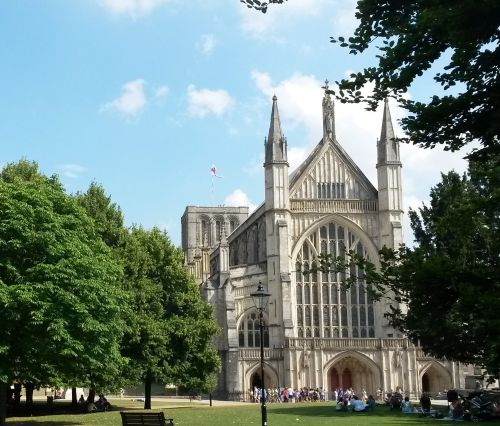Basingstoke and surrounding area
What to do and see in the "Wessex Way".
Winchester
Potted history of Winchester
Winchester began as a Roman town. It was built about 70 AD. The Romans called the new town Venta Belgarum which means the capital of the Belgares (who were the local Celtic tribe before the Roman conquest).
The last Roman soldier left Britain in 407. Town life then broke down. Winchester seems to have been abandoned. When the Saxons arrived in the 6th century a small number of them may have lived in wooden huts within the walls and farmed the land outside.
From 597 monks from Rome began the task of converting Southern England to Christianity. In the mid 7th century a Minster church called the Old Minister was built inside the Roman walls. In 676 the Bishop of Wessex moved his seat to Winchester and the Old Minster became a cathedral
Late in the 9th century Alfred the Great revived the old Roman town. To defend his kingdom he formed a network of fortified places where men could gather to fight the Danes whenever necessary.
William the Conqueror rebuilt the Royal Palace in Winchester.
 After 1079 the Normans demolished the Old Minster Cathedral and built a new cathedral on the site. The New Minster monastery was moved to a new site north of Winchester. In the Middle Ages the church ran the only 'hospitals'. In 1136 the Hospital of St Cross was built in Winchester. Wolvesey Castle, the Bishops residence, was built early in the 12th century.
After 1079 the Normans demolished the Old Minster Cathedral and built a new cathedral on the site. The New Minster monastery was moved to a new site north of Winchester. In the Middle Ages the church ran the only 'hospitals'. In 1136 the Hospital of St Cross was built in Winchester. Wolvesey Castle, the Bishops residence, was built early in the 12th century.
In the 13th century the friars arrived in Winchester. Medieval Friars were like monks except instead of withdrawing from the world they went out into the world to help the poor and the sick and to preach. The Dominican friars (known as black friars because of their black costumes) arrived about 1230. Franciscan friars (called grey friars) arrived in Winchester in 1237. Carmelite friars followed them in about 1278.
Between 1135 and 1154 there was civil war in England between Stephen and Matilda. In 1141 a battle was fought in Winchester, which became known as the rout of Winchester. The bishop of Winchester fell out with Matilda and his men took refuge in Wolvesey castle. Matilda's army then occupied the town of Winchester and laid siege to the castle. However Stephen's army surrounded Winchester. So there was the strange situation of an army in Wolvesey castle, under siege from an army in the town, under siege from another army outside the walls! Matilda's army eventually decided to fight their way out of Winchester and went out through the town gates.
More trouble followed in 1264 when there was civil war between the king and his barons led by Simon De Montfort. The people of Winchester supported the king but the monks in the town supported De Montfort. In 1264 they came to blows when the townspeople found out the monks were planning to let De Montfort's men into the town through the Kings gate. The townspeople killed several monks and set fire to the Canon gate. De Montfort's men captured Winchester.
In 1538 Henry VIII closed the St Marys Abbey (Nunnaminster), Hyde Abbey and St Swithun's Priory. He also closed the friaries in Winchester.
In 1554 Queen Mary married King Phillip of Spain in Winchester.
In 1642 civil war began between King and Parliament. During the civil war Winchester changed hands several times. Most of the people in Winchester supported the king and at first royalist soldiers occupied the town. However at the end of 1642 parliamentary soldiers attacked and quickly captured Winchester. The town council paid the parliamentary soldiers £1,000 in return for an agreement that they would not loot the town but some soldiers did so anyway. They also vandalised the cathedral.
In 1724 Daniel Defoe wrote that Winchester was a 'place of no trade, no manufacture, no navigation'. On the other hand 'here is a great deal of good company the abundance of gentry being in the neighbourhood, it adds to the sociableness of the place. The clergy here are generally speaking very rich and numerous'. In 1755 Horace Walpole called Winchester 'a paltry town and small'.
Jane Austen died in College Street, Winchester and was buried inside the Cathedral in 1817.
In 1901 a statue of King Alfred was erected to commemorate the 1,000th anniversary of his death.
Milestones Museum
Milestones Museum of Living History is a museum located on the Leisure Park in Basingstoke. Milestones is made up of a network of streets that have been recreated according to those found in Victorian and 1930s Hampshire.
Basingstoke Leisure Park, Churchill Way West, Basingstoke RG22 6PG 01256 639550
https://hampshireculturaltrust.org.uk/milestones-museum



